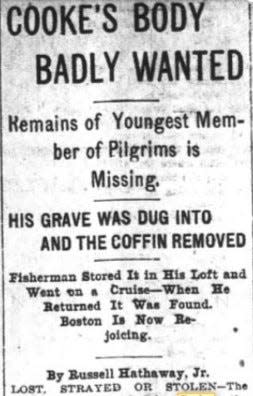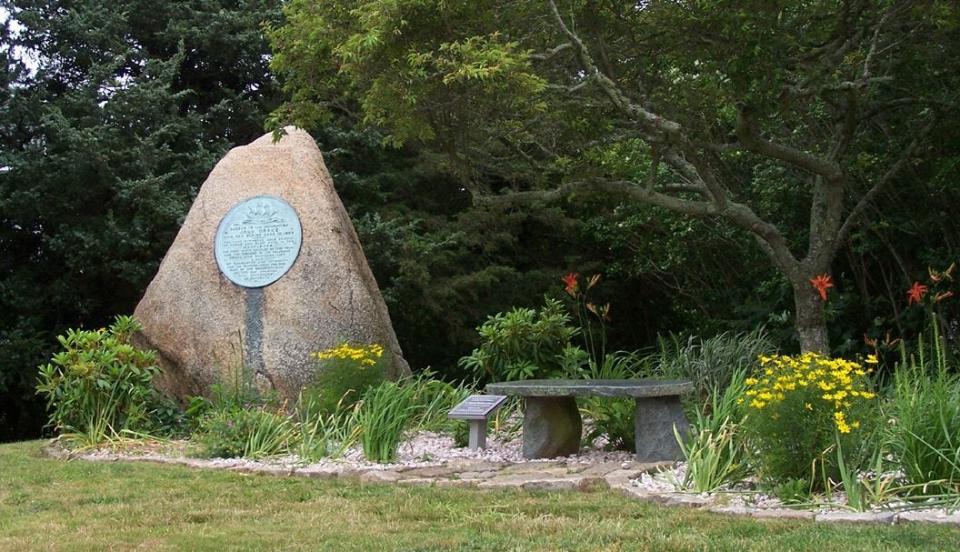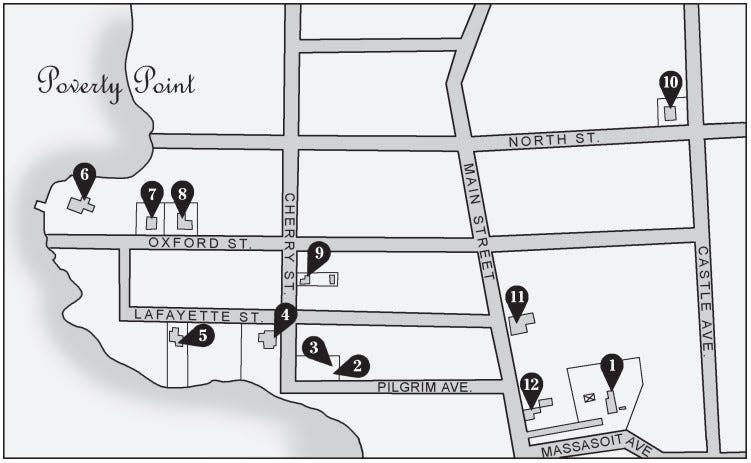Unidentified children's skeletons, a 'missing' Pilgrim: Fairhaven's Poverty Point mysteries
FAIRHAVEN — Tales of a missing body of a Mayflower Pilgrim, unearthed skeletons of two children, and a newly-built bridge that ruined lives swirl around the waterfront neighborhood of Oxford Village, also known as Poverty Point.
Bounded by Pilgrim Avenue, Lafayette, Oxford, North, Cherry, and Main Streets, along with Castle Avenue and Massasoit Avenue, Poverty Point was anything but during the 1700s. The quaint neighborhood that overlooks New Bedford Harbor was dotted with large homes, primarily lived in by sea captains during the times of the bustling whaling industry.
John Cooke, a Pilgrim who came over on the Mayflower in 1620, was 13 years old when he arrived in Plymouth with his father. In his adult life, he eventually settled in Fairhaven.
Mayflower II pics: Mayflower II stops in New Bedford on way back to Plymouth
He was the last known surviving male Pilgrim of the Mayflower when he died in 1695. He is buried at Burial Hill, better known as the Cooke Memorial Park, on Pilgrim Avenue.
Or is he?
The headlines in the 1902 edition of The Constitution: Atlanta Georgia screamed “Cooke’s Body Badly Wanted. Remains of Youngest Member of Pilgrims is Missing.”
It’s a mystery even to this day.

The article, written by Russell Hathaway Jr., crafted the headlines as sort of a spoof advertisement calling for the return of Cooke’s body after it supposedly went missing. In the article, Hathaway claims that Cooke’s body was dug up and somehow wound up wrapped in sail cloth and hidden high in the rafters of a fisherman’s shed, who apparently had stored the body while he was out at sea.
“I was afeared thet some of those durn boys would steal him, jest out o’ deviltry. So I wrapped him up in a piece o’ sail cloth an’ put him up under my shed roof,” the fisherman said, according to Hathaway’s article.
Curious SouthCoast: Have you seen the storybook scene on this local abandoned building? A mystery worth saving
Disputing the claim that Cooke was buried at Burial Hill, Henry B. Worth wrote in 1911, "Without some record there can be no certainty where John Cook’s grave is located, but judgment cannot be rendered in favor of the Oxford tradition."
Worth, pointing to several land deeds, and Cooke's own will, notes that Cooke owned burial ground property in Acushnet.
"In the light of this record there is strong reason to suppose that Cooke was laid in the point purchased by him and transmitted to his descendants. Opposed to this is the tradition that he was buried at Oxford on a lot which he never owned and in which he is not known to have had any interest, and where there was never an inscribed stone marking any grave," Worth wrote.
Just what really happened to Cooke's body and where his remains are buried continue to be debated today.
Around 1902, when the town decided to build a memorial to Cooke at the Oxford burial site, the grounds were dug up to make way for a large boulder that would bear a plaque in his honor.

During the excavation, four decaying coffins were dug up – two held the skeletons of men and the other two held the skeletons of children. The area of Burial Hill was a graveyard, however, many of its interred were not documented.
The Fairhaven Star interviewed Ruth M. Boomer in 1888. She was 89 years old at the time and told the newspaper she lived in the area as a little girl. She remembered there were about 20 graves in the cemetery including Fenno Winslow who drowned in 1810, an “Indian” girl, and the infant son of Seth Allen.
The bodies of the two children uncovered during the excavation for the Cooke memorial were never identified and were said to have been reburied that same day elsewhere on the site.

Poverty Point, some believe, got its nickname sometime after 1797 when a narrow drawbridge connecting Fairhaven and New Bedford was built. Shipbuilding was a strong industry, but after the bridge went in, it cutoff the shipyards to the north along Oxford Village. Several shipyards packed up and moved operations south of the bridge, eventually settling in what would become Fairhaven Center where whaling and shipbuilding again prospered.
With shipbuilding gone from Oxford Village the area wasn’t as prosperous and that is how some believe Poverty Point got its name.
Curious SouthCoast: Drastic measure to stop massive 1859 New Bedford blaze haunted fire chief the rest of his life
According to the book Old Time Fairhaven: Erstwhile Eastern New Bedford, by Charles A. Harris in 1947, that part of town possibly got its nickname after two events in the very early 1800s. The book states the term Poverty Point was used in real estate deeds as far back as 1810.
It seems Robert Bennett “the leading man of the village” suffered a great financial disaster at the time. Then the sloop Thetis with 34 men aboard, wrecked off the coast of Cape Hatteras – only five survived. The books says while only three of the dead were from Oxford Village, urban legend contends the wreck left behind “many widows with children” and that’s how the neighborhood came to be called Poverty Point.
Walking tours of Poverty Point are conducted by the Fairhaven Office of Tourism and are led by historian Christopher Richard.
Many of the homes from the 1700s are still standing in the neighborhood today. Along the tour, Richard, points out the homes owned by “the first Japanese person to live in America, the first man to sail around the world alone, the founder of the Seventh-day Adventist Church, and the woman who had a school named after her while she was still its principal,” according to the tourism website.
Download our app! Standard-Times digital producer Linda Roy can be reached at lroy@s-t.com Follow her on Twitter at @LindaRoy_SCT. Support local journalism by purchasing a digital or print subscription to The Standard-Times.
This article originally appeared on Standard-Times: Fairhaven's Poverty Point and its unsolved mysteries

